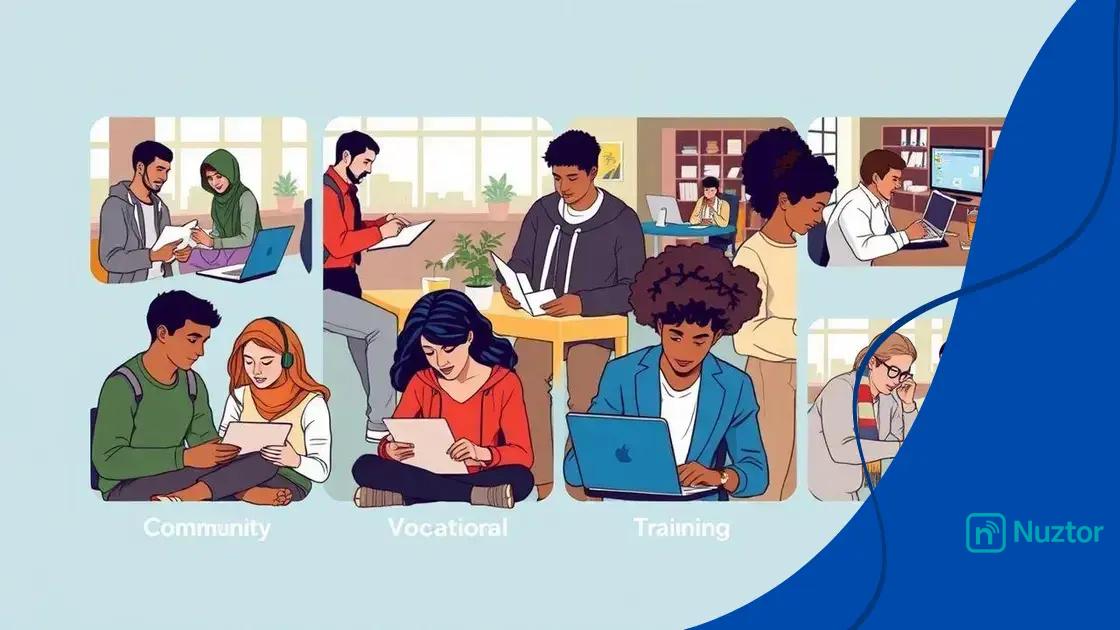College affordability crisis solutions you can explore now

The college affordability crisis solutions include exploring community colleges, vocational programs, leveraging financial aid, and advocating for state policies that support education funding to ensure access for all students.
College affordability crisis solutions are crucial for many families today. As tuition prices soar, it’s essential to explore effective strategies that can ease the strain on students. Let’s dive into some practical solutions that might just help you manage those rising costs.
Understanding the college affordability crisis
The college affordability crisis is impacting many families across the nation. Understanding why college costs are rising is important for anyone considering a higher education. It involves complexities such as tuition, fees, and living expenses. By exploring these factors, we can better grasp what contributes to the financial burden students face.
Factors Contributing to Rising Costs
Several elements play a role in escalating college prices. These include:
- The increasing demand for college education
- Administrative costs rising faster than inflation
- State funding cuts affecting public institutions
- The high costs of maintaining and upgrading facilities
Additionally, student debt has become a significant concern. As more students take out loans to cover costs, the total debt load increases, perpetuating the issue. Many graduates find themselves struggling to pay off these debts, which can affect their financial independence for years.
The Role of Financial Aid
Financial aid is intended to help alleviate the costs of college. However, many students often do not fully understand their options. Scholarships, grants, and work-study programs can make a significant difference in reducing financial burdens. Yet, students must actively seek out these opportunities and apply early.
Moreover, the confusion around financial aid processes can leave some students feeling overwhelmed. It’s crucial to simplify these processes and ensure all students have the necessary information to make informed decisions about their education funding. By improving awareness and accessibility of financial aid, we can make strides toward addressing the college affordability crisis.
Understanding the cost of college isn’t just about numbers; it’s also about the impact of these costs on future generations. When families know what to expect regarding expenses, they can better plan and explore alternatives. This awareness is the first step in navigating the complexities of college costs and finding potential solutions.
Financial aid options for students
Financial aid options for students can significantly ease the burden of college costs. With a variety of resources available, it’s important to recognize what is out there and how to access it. Understanding these options can greatly influence a student’s ability to afford higher education.
Types of Financial Aid
When looking at financial aid, there are several types to consider. Each type serves a different purpose and can help in various ways.
- Grants: These are often need-based and do not require repayment.
- Scholarships: These are awarded based on merit, talent, or other criteria and also do not need to be repaid.
- Loans: These must be paid back with interest, which can be a long-term commitment for students.
- Work-Study: This program allows students to work part-time while studying, earning money to help cover expenses.
Each type of aid has different eligibility requirements and applications, which makes it essential to research thoroughly. Many students may feel overwhelmed by the complexities of applying for financial support, but there are resources available to help navigate these waters.
Applying for Financial Aid
The process of applying for financial aid generally begins with the Free Application for Federal Student Aid (FAFSA). Completing this form is essential for determining eligibility for federal student aid programs. Students should ensure that they fill out the FAFSA accurately and on time.
It’s also wise to check for specific scholarships offered by colleges, private organizations, and community groups. Scholarship applications might involve essays, interviews, or other requirements, so getting started early can be beneficial. Additionally, reaching out to a school’s financial aid office can provide students with personalized guidance through their financial aid options.
Ultimately, utilizing available resources can empower students to finance their education. By understanding and exploring the various financial aid options, students can take critical steps towards a successful academic journey without becoming overwhelmed by costs.
Alternatives to traditional college

Exploring alternatives to traditional college can open up various opportunities for students. As the #college affordability crisis continues, many learners are seeking paths that offer both education and practical experience without the hefty price tag of a four-year university.
Community College
One popular option is attending a community college. These institutions often provide lower tuition rates and a supportive environment for students. Community colleges can offer a wide array of programs that allow students to earn degrees or certificates.
- Affordability: Generally, tuition is much lower compared to four-year universities.
- Flexible schedules: Many community colleges offer evening and weekend classes.
- Transfer options: Students can complete their general education courses and later transfer to a university.
These features can make community college an attractive option as students pursue their academic and career goals.
Vocational Training
Another route is vocational training, focusing on practical skills needed for specific jobs. Programs in areas like healthcare, technology, and skilled trades provide direct paths to employment. These programs are often shorter than traditional degrees and can lead to well-paying positions.
Vocational schools regularly collaborate with local businesses, which helps students gain real-world experience. This connection can also assist in job placement after graduation, ensuring that students enter the workforce with relevant skills.
Online Learning
Online learning is also an increasingly popular choice. Many reputable institutions offer online degrees and certifications. Distance education allows flexibility for those balancing work, family, or other commitments.
Students can learn at their own pace while accessing resources from anywhere. This option can be particularly appealing to non-traditional students looking to upskill or change careers.
As you can see, there are multiple alternatives to traditional college that can help students succeed without incurring massive debt. It’s crucial for students to research and consider all available options that align with their personal and professional goals.
Community and state initiatives
Community and state initiatives play a vital role in addressing the college affordability crisis. These programs often aim to provide support to students and families, ensuring that education is accessible to all. Various strategies are being employed at the local and state levels to help reduce the financial burden of college education.
Local Scholarships and Grants
Many communities offer scholarships and grants to support local students pursuing higher education. These funds can significantly lessen the costs of tuition and other expenses.
- Community foundations: These organizations often provide grants based on need or merit.
- Local businesses: Many businesses sponsor scholarships to encourage local talent and give back to the community.
- School district programs: Some local school districts offer scholarship programs specifically for their graduates.
These local funding opportunities can be instrumental in helping students achieve their academic goals.
State Funding and Programs
At the state level, governments provide various programs designed to ease the financial strain on students. Many states offer funding programs that help keep tuition costs lower at public universities. For instance, some states have established programs that cover the cost of community college tuition for residents.
States also implement outreach initiatives to inform students and families about available financial aid options. This proactive approach is essential in helping families navigate the complexities of financing education. By improving access to information, many students can take advantage of financial aid programs that may have gone unnoticed.
Partnerships with Nonprofits
Additionally, partnerships between universities and nonprofit organizations are increasingly common. These alliances often focus on providing underrepresented students with access to college resources, support, and workshops to help with the application process.
Such collaborations can positively impact educational attainment, as they often lead to enrichment programs, mentoring, and academic support. These community-driven efforts highlight the importance of collective action in tackling the affordability crisis.
In short, community and state initiatives can lead to tangible solutions that empower students. By focusing on local resources and creating supportive environments, we can work toward a future where college education is more affordable and accessible for everyone.
Long-term solutions to reduce costs
Finding long-term solutions to reduce costs in higher education is essential in addressing the college affordability crisis. By implementing strategies that focus on sustainability and efficiency, schools can create a positive impact on future generations of students.
Investing in Technology
One effective solution is investing in technology. Modern tools can help streamline administrative processes, reduce operational costs, and enhance learning experiences. By adopting online platforms for course delivery, institutions can lower expenses while maintaining educational quality.
- Online courses: Offering hybrid or fully online courses can save on physical infrastructure costs.
- Efficient administration: Implementing management software can optimize resources and reduce spending.
- Digital resources: Utilizing e-books and online materials can cut down on textbook expenses for students.
By focusing on digital innovation, colleges can efficiently allocate resources, ensuring that funds are used effectively.
Collaboration with Local Communities
Another long-term strategy involves collaborating with local businesses and community organizations. Such partnerships can create opportunities for internships, mentorships, and job placements, which enhance student learning and employability.
These collaborations can also lead to financial support in the form of scholarships or resources for campus projects. Engaging local stakeholders helps to create a sense of shared investment in educational outcomes.
Policy Changes at the State Level
Advocating for policy changes at the state level is crucial. Governments can play a significant role in reducing costs by increasing funding for public institutions and ensuring transparency in tuition pricing.
Additionally, states can promote programs that incentivize institutions to be financially responsible. By prioritizing funding for low-income students and emphasizing affordable degree programs, states can encourage greater access to education.
Overall, implementing long-term solutions to reduce costs requires a collaborative effort among educational institutions, state governments, and local communities. The focus should be on creating a system that values education while ensuring that it remains affordable for all.
In conclusion, addressing the college affordability crisis requires a multifaceted approach. By exploring alternatives to traditional college, utilizing community and state initiatives, and investing in long-term solutions, we can make education more accessible. Students, families, educators, and policymakers must work together to create a brighter future for all learners. By supporting innovative strategies and fostering collaboration, we can reduce the financial burden of higher education and ensure that everyone has the opportunity to succeed.
FAQ – Frequently Asked Questions about College Affordability Crisis Solutions
What are some alternatives to traditional college?
Alternatives include community colleges, vocational training programs, and online learning, which can be more affordable and flexible.
How can students find financial aid?
Students can search for financial aid options through scholarships, grants, and the FAFSA application for federal assistance.
What role do community and state initiatives play?
Community and state initiatives provide funding, local scholarships, and support programs that help reduce the cost of education.
What are some long-term solutions to the college affordability crisis?
Long-term solutions include investing in technology to streamline costs, collaborating with local businesses, and advocating for state policy changes to increase funding.